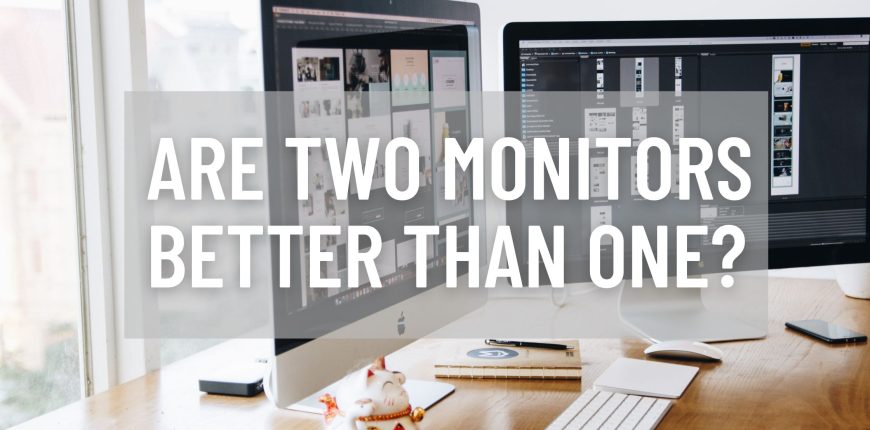What do you think about when you see someone using two computer monitors. Maybe you assume they are extremely tech-savvy or doing some kind of specialized work that requires that much screen real estate. But, are two monitors better than one?
The reality is, even if you spend all day going over documents, having the extra display space that a second screen offers can be very helpful.
It’s common to feel confinement with the screens we already have. Smaller screens make it difficult for us to accommodate two windows side by side.
Most of us have the experience of navigating through a layer of various apps to find the window we truly want. This is one of the things that takes up time throughout the day and using two displays can eliminate that.
In a research study by software developer Mavenlink, 73% of the businesses claim they spend over an hour a day switching between different apps and windows.
Research on Dual-Screen Productivity
The real question is, how much of a productivity boost do you get from using a second monitor? Maybe more than you think.
For many years, Jon Peddie Research studied the advantages of having two displays attached to a desktop or laptop. Overall, it was shown that workers in all occupations may increase output by an average of 42%.
Three studies done over a 15-year period revealed a considerable increase in the use of two monitors between 2002 and 2017, with a compound annual growth rate of 10%.
The founder of the firm succinctly stated, “The more you can see, the more you can do.”
What Benefits Can Adding a Second Screen Offer?
Maximize your output while minimizing your effort.
The main benefit of using a second monitor is that you can do more tasks faster since you won’t have to exert as much effort to access windows when you need them.
You can work in other applications on the second screen while keeping email open on the first screen if you have a second monitor. You are able to operate more efficiently and quickly access all of your apps.
Expands Laptop Screen Space
The mobility of laptops is great, especially while traveling or commuting between the home and the office (as many employees do these days). However, the screen size decreases as a laptop becomes more portable.
The smaller monitor on a laptop is a significant disadvantage. The complexity of placement is another issue. People frequently attempt to raise them when using them at a desk, but most of the time they are still looking down at the screen.
The way to enhance your laptop experience is connecting it to a monitor. It makes it more like a standard desktop PC. You have the option of mirroring your complete screen or continuing to utilize your laptop’s screen for some task while switching to the bigger screen for others.
Simplify Side-By-Side Comparisons
There are plenty of tasks the require the use of two windows at once. You can be revising or comparing designs to the original instructions. Or you might need to add information from your notes into a Powerpoint presentation.
It is challenging to have two windows open side by side on a single screen. If you try to adjust the window size precisely, you could find that when you maximize the screen to scroll, your configurations are lost.
You have the screen space you need to completely open both windows and have them adjacent to one other so you can quickly and accurately complete your job when you have two monitors.
Added Flexibility During Video Calls
Have you ever wanted to check an email or review notes while screen sharing on a video call? Doing it while everyone can see your screen is challenging. Before a meeting, we frequently “sanitize” our screens (by turning off alarms, etc.) to make sure nothing that shouldn’t be there is.
When you have two displays, you can choose which one to use for meetings while leaving apps open on the second screen that no one can view. If you need to check your email or message someone while you’re sharing your screen, this is a huge benefit.
Cost-Effective Productivity Booster
When you consider technology as an investment, buying another display is a rather inexpensive expenditure. The typical price range for a monitor is between $125 and $250. With an average productivity boost of 42%, the ROI can be pretty great.
The best part about an additional display, is that there is little to no learning curve. It’s an extension of your own device that’s ready to use as soon as it’s connected. Of course, expect some configuration, but besides that you’re good to go. Users can move around apps and windows across the screen by simply dragging them, just as if they have one big screen.
Need Assistance Increasing Productivity?
The appropriate technology and tools may increase productivity in a number of ways, and they don’t have to be expensive. Ask us how we can assist you!
Check out our last blog post on how to revive an old computer.
Call us at (323) 761-2634. We’d be happy to assist you and all your technology needs.
We are located in West Hollywood, servicing the greater Los Angeles area!

